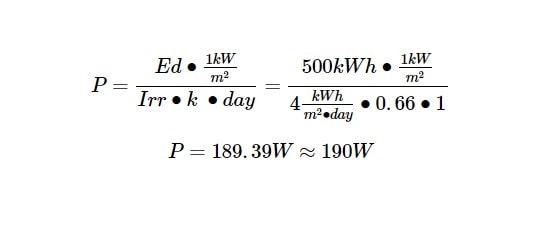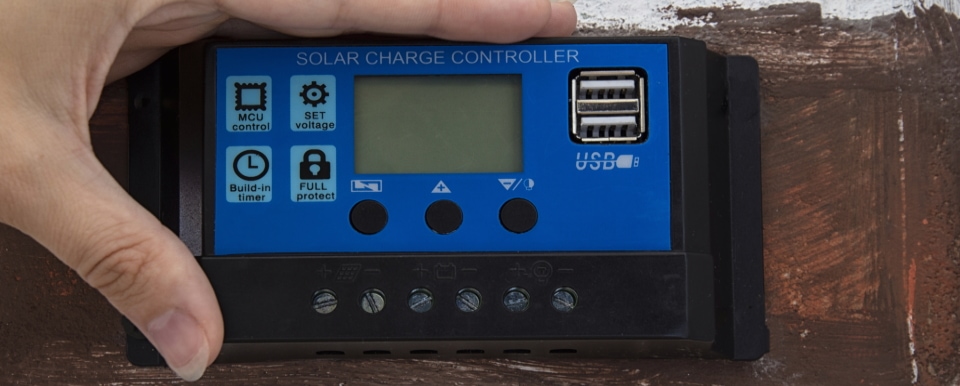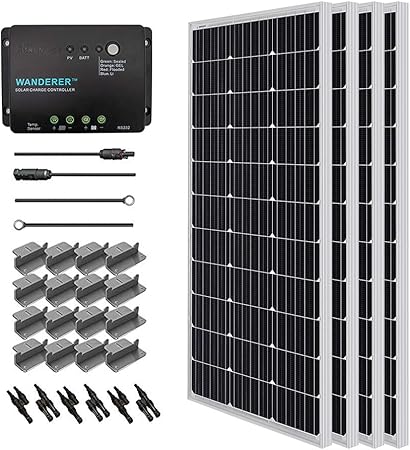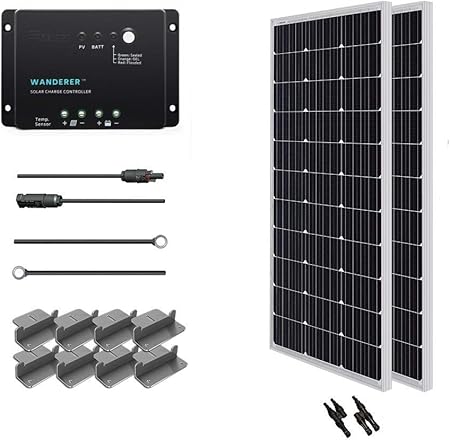
7 Best Solar Panel Kits in 2021 (Review)
Solar energy is undoubtedly the most cost-effective renewable energy source of the last decade. No wonder more and more people are bringing solar panels into their homes, whether they’re trying to be more eco-friendly and sustainable, or hoping to profit from the purchase.
The price of solar panels keeps declining, but a great way to cut expenses further is through a home solar panels kit. These kits include panels, a charge controller, and all the required hardware for a DIY installation.
Buying a solar panel system kit is the easiest and most affordable way to start into solar for your home, removing the expenses of a professional electrician.
Written by qualified solar engineer Carlos. Last updated:
Page Contents
The following article highlights the best solar panel kits in 2021 and reviews some of their most important features and characteristics.
Short on Time? See our Top Rated Products From 3 Categories

Goal Zero Venture 30 Solar
- Weatherproof suitcase solar panel kit
- Portable and handy solar panel and battery pack
- Capable of charging two devices at once

Renogy 100 Monocrystalline
- PWM charge controller kit included
- Expandable and easy to install
- 12-volt system

Goal Zero Yeti 400
- Portable Power Station (AC and DC output)
- 3 ways of charging
- Kickstand self-supporting panel
Where To Buy
The Best Solar Panel Kits
1. Goal Zero Venture 30 Solar Kit

Key Features:
- Weatherproof suitcase solar panel kit
- Portable and handy solar panel and battery pack
- Capable of charging two devices at once
Key Specifications:
- Dual 2.4 Amp USB high-speed charging ports
- Weighs 3 pounds (1.3 kg)
- Built-in tangle-free charging micro-USB cable
The Goal Zero Nomad 10 + Venture 30 solar kit is the perfect solution for any trip where extra power is required from a solar-powered bank.
This is one of the small home solar panel kits that features the Nomad 10, a 10-watt monocrystalline lightweight and foldable solar panel. It comes with a built-in kickstand for multiple angle positioning and a back mesh to store any electronic components.
The kit includes the Venture 30 Power Bank, a 7.800mAh battery pack with a weatherproof design with an IP rating of IPX6. It features dual 2.4 amp USB ports and one micro-USB cable. The main USB port sits on top, while the other USB port and micro-USB cable are on independently built-in cables incorporated into the unit.
The Nomad 10 easily connects through its 5 Volt, 1.5 Amp USB port to the Venture 30, so you can charge up the unit while stationary or on the go. This product solves any power requirements while fishing or camping, working as perfectly as any other off grid solar panel kits.
Renogy 100 Watt 12 Volt Monocrystalline Solar Starter

Key Features:
- PWM charge controller kit included
- Expandable and easy to install
- 12-volt system
Key Specifications:
- 100-watt monocrystalline panel
- 30 Amp rated charge controller
- Capable of handling up to 4 panels
Renogy leads the market with one of its solar starter kits, the Renogy 100 Watts 12 Volt Monocrystalline. Solar Starter Kit Renogy’s starter kit comes with everything required to assemble and run a solar energy system, making it a great solar panel kit for sheds, RVs, boats, or any other off grid application.
Like many complete solar panel kits, this includes a highly efficient 100W 12V monocrystalline Solar Panel, along with one Wanderer-Li PWM charger of 30 amps to control and improve the system performance. It also includes a 20ft 10 AWG Solar Adaptor kit, which has preassembled 20ft (6m) long 10 AWG cables with MC4 connectors, one 8ft (2.4 mt) 10 AWG Tray cable, and a set of Z-brackets, for easy installation.
Renogy’s kit includes all essentials except for a battery bank, but this can be purchased separately easily enough. The Wanderer-Li Charger supports Lead-Acid (Gel, AGM, and Flooded) and lithium batteries.
The system’s status can be easily tracked through the Wanderer-Li Led indication lights, or through the optional BT-1 Bluetooth module on the Renogy BT smartphone app.
3. Goal Zero Yeti 400 Solar Generator Kit

Key Features:
- Portable Power Station (AC and DC output)
- 3 ways of charging
- Kickstand self-supporting panel
Key Specifications:
- 396 watt hours, AGM Lead-Acid battery
- Aluminum frame solar panel
- Pure sine wave inverter (300W continuous, 600W surge)
Where To Buy
The Goal Zero Yeti 400 Solar Generator kit features the Goal Zero Yeti 400 Portable Power Station and the Boulder 50 monocrystalline solar panel.
This Goal Zero Yeti 400 is a portable Power Station, weighing around 29lbs (13.2 kg) and offering a maximum of 396 watt hours (39 Ah at 12 volts) of energy. Small but powerful, it features an AGM Lead-Acid deep cycle battery pack, a pure sine wave AC inverter, capable of 300 watts continuous and 600 watts surge maximum capacity, and several DC charging ports.
The Boulder 50 is a 50-watt monocrystalline solar panel, built with tempered glass and an aluminum frame, with corner protections for maximum durability and stability. The panel is equipped with an integrated easy to set kickstand to help you get an optimal angle to the sun when configured as ground mount.
The Yeti 400 can be charged in three ways: through the Boulder 50, one of the greatest ground mount solar panel kits, through the wall charger, or through the 12 VDC car adapter, in about 4-6 hours.
4. Renogy 400 Watt 12 Volt Monocrystalline Solar Starter Kit
Key Features:
- PWM charge controller kit
- Multiple battery options
- 12-volt system
Key Specifications:
- 100-watt monocrystalline solar panels
- Up to 2000 Wh daily electricity load
- 30 Amp charge controller
The Renogy 400 Watt 12 Volt Monocrystalline solar panel kit is the biggest Renogy’s kit offered in the starters’ section.
The off grid solar panel kit includes four Renogy 100-watt efficient monocrystalline panels, one PWM charge controller, the Wanderer-Li with 30 amps of capacity, one 20ft (6m) 10 AWG Solar Adaptor Kit (preassembled cables with MC4 connectors), one set of 8ft (2.4m) 10 AWG Tray cables, three pairs of branch connectors (for easy interconnections among panels), and four sets of Z-brackets.
The Renogy 100 Watt panels feature an open voltage of up to 21.6 Vdc, and the maximum input voltage of the controller is up to 25.5 Vdc. This means that the kit is designed for parallel connections among the panels. The branch connectors facilitate this task, making the interconnection of the system as easy as plug and play.
Like the other Renogy starter kits, this one doesn’t include a battery pack, but the Wanderer-Li supports many battery options, meaning the selected battery pack can accommodate different requirements and budgets, and still be compatible with the kit.
5. Goal Zero Yeti 150 Solar Generator Kit
Key Features:
- Portable Power Station (AC and DC)
- 3 ways of charging
- Kickstand self-supporting panel
Key Specifications:
- 168 Wh, AGM Lead-Acid battery pack capacity
- Strong and rigid aluminum framed solar panel
- Pure sine wave inverter (80W continuous, 160W surge)
Where To Buy
Goal Zero Yeti 150 Solar Generator kit comes with the Yeti 150 portable power station, the smaller brother of the Yeti 400, and the same Boulder 50 monocrystalline and highly efficient solar panel.
The Yeti 150 portable power station is an all-in-one battery pack for charging all types of electronics. Its AGM Lead-Acid deep cycle battery pack has a peak capacity of 168 watt hours (at 12 Volts, 14 Ah). The integrated pure sine wave AC inverter achieves a maximum output of 80 watts continuous and 160 watts at surge power. It also comes with 2 USB ports, one 6mm 12 volt port, and a 12 volt car port as DC outputs.
The Yeti 150 Solar Generator kit also incorporates the Boulder 50 as its solar panel and it can fully charge the unit in about 6-12 sun hours.
The Yeti 150, as with all the Yeti series, incorporates independent 12 volts, USB, and AC power buttons on the front panel, and its built-in display shows power input, output, and available capacity at any given time.
6. Renogy 200 Watt 12 Volt Monocrystalline Solar Starter Kit
Key Features:
- Expandable kit
- PWM charge controller kit
- 12-volt system
Key Specifications:
- Up to 1000 Wh daily in an ideal situation
- 100-watt monocrystalline panels
- 30 Amp charge controller
The Renogy 200 Watt 12 Volt Solar Starter kit includes two 100 Watt 12 Volt monocrystalline solar panels and one Wanderer-Li PWM charge controller, rated for 30 amp. It also includes one 20ft (6m) 10 AWG Solar adaptor kit (preassembled MC4 connectors with 10 AWG cable), one 8ft (2.4m) 10 AWG Tray Cable (for battery connection), a pair of branch connectors, and two sets of Z-brackets for the panels.
This 200-watt kit works as an expansion module for energy solar systems, or as an off grid small independent system. Its PWM charge controller, the Wanderer-Li, can handle up to four 100 watt panels.
The kit does not come with a battery pack, but its controller can integrate many battery options, making the battery selection and installation straightforward.
The Wanderer-Li includes battery protection features to prevent overcharging, over-discharging, overload, or a short-circuit, which helps to extend the system’s life as much as possible.
The system’s status can be tracked through the incorporated LED lights, or it can be tracked through an additional Bluetooth module and Renogy’s BT smartphone app.
7. Acopower 500 Watt 12/24 Solar Panel Kit
Key Features:
- Compatible with Lead-Acid and lithium batteries
- Easy to install and complete kit
- Waterproof entry cable housing
Key Specifications:
- 40 Amp MPPT charge controller
- Five 100 Watt polycrystalline solar panels
- Automatic 12/24 Vdc detection
Where To Buy
Acopower 500 Watts is one of the best RV solar panel kits, with an MPPT solar charge controller specially designed for cars, boats, or green homes.
This solar panel off grid kit includes five 100 watts polycrystalline modules and one MPPT controller rated for 40 Amps, along with a pair of 30ft (9.1m) 12 AWG cables with MC4 connectors. It also includes one pair of 8ft (2.4m) 8 AWG Tray cables to connect to the battery, mounting sets, entry cable housing, and 4 pairs of T/Y branch connectors.
Its MPPT controller is the heart of the kit. It can automatically identify 12/24 VDC systems and supports Lead-Acid (AGM, Flooded, and Gel) and lithium batteries. It supports up to 520 watts on 12 volt systems, and 1040 watts on 24 volt systems.
Its Maximum Power Point Tracking algorithm achieves an efficiency of 99.5%.
The kit designed for use on an RV or car, with waterproof entry cable housing allowing you to run the cables from the solar panels on the roof up to the MPPT controller and additional batteries.
Solar Kits – Buying Guide and FAQ
Features to Look for in Solar Kits
Apart from the price, here are some of the main features to look for when searching for solar kits:
Efficiency
Whether the panel is monocrystalline or polycrystalline and whether the charge controller is an MPPT or a PWM controller drastically affects how efficient your system will be, and how much energy will you get from it.
IP rating
The Ingress Protection code or rating lets you know exactly the degree of protection against dust and water which the casing provides to the electrical components. This rating facilitates the comparison between types of equipment, rather than vague “waterproof” descriptions.
Size and portability
Whether you want an on-the-go kit or a stationary solar system, weight, size, and even foldability are some of the main things to look out for.
Wattage
The watts of a panel or a charge controller determine how much energy you will be able to deliver with that specific equipment. The wattage of your panels often determines the wattage of the kit, as that will describe how much power you’ll be able to generate.
Voltage and Battery Capacity
System voltage is a really important feature to look out for, as it will determine the efficiency of your system. The 12 volts systems are mainly for small solar panel kits and beginner-friendly kits, while 24 and 48 volts systems are for bigger kits and equipment with big loads and more efficient requirements.
The capacity of your power bank will vary depending on the system voltage (12, 24, or 48V). The amp-hours rating of your battery tells you how much energy a single battery can supply, but increasing the system voltage will reduce the amount of energy that is needed to serve a load. In other words, the system voltage plays a vital role in configuring the battery capacity of the power bank.
Solar Kits FAQ

Q: Do I need any extra equipment?
A: The main components of any solar system are:
- Solar panels
- Charge controller
- Batteries
- Inverter
- Connecting cables
- Mounting hardware
In most of the kits, neither the battery nor the inverter is included, so you will need to purchase them separately. Selecting a battery mainly comes down to the Ah capacity needed, the technology (Lead-Acid or lithium), and the voltage. All systems need a battery, but an inverter is optional.
If you are going to power small appliances, you will need an inverter for an off grid solar panel kit. For this, you mainly need to consider the nominal wattage rating, the surge power, the input voltage system (which must match the battery system voltage), and the voltage output.
Q: How to choose my battery size?
A: As with everything in the electric world, this depends on what you want to power. Selecting a battery is not as hard as it sounds.
First, you need to analyze and list how many devices you want to power and how many watts each consumes. Once you know the power consumption of your total daily electricity load, you have to decide how many hours of backup you need to supply the total energy consumption.
For example, if you want to power a mini-fridge that consumes around 50 watts, and also have some extra power for electronics (around 6 watts per charger), you need to add up the wattage, which represents around 80 watts. Next, you need to multiple it by the hours you want of backup. Let’s assume you want 4 hours. In this case, 50 watts x 4 hours equals 200 watt-hours. This means your battery bank should be around 200 Wh.
If you want to know the capacity in amp-hours, you just need to divide the watt hours by the system voltage (12 volts for instance).
Q: How many panels do I need?
A: Again, this depends on your load. As with the battery sizing, you need to know your load’s total power consumption and the size of the battery system if you want to size the panels to power them.
Sizing a solar panel system can get complicated, but in general, it mainly depends on the global solar radiation of your area, which can be found by checking a solar map in Solargis. The average in the US is about 4h.
This means that if you have a 100-watt panel on the roof, on an average sunny day, you will be getting around 400 Wh of energy during the day. However, we must also consider a derating factor to represent the solar PV system losses, estimated at 0.66. As an example, if we have a demand of 500Wh daily electricity load, then the calculation can be done as follows:

Q: What are monocrystalline and polycrystalline panels?
A: These are both panels that produce electricity from the sun, and they are both made out of silicon cells. The main differences between them are their efficiency and cost.
Monocrystalline panels are the “high end” panels as they are more expensive and have a greater efficiency of around 20%. The cells of the panel are made out of a single silicon crystal wafer and tend to be black in color.
Polycrystalline panels are more affordable as they achieve a conversion efficiency of around 18%. Their cells are made of several silicon crystals mixed into a single wafer, and they tend to have a more blue-like color.
Q: What are MPPT and PWM solar charge controllers?

A: The sun’s brightness varies throughout the day, which means the PV arrays produce fluctuating energy all the time, depending on the amount of light that reaches them.
A solar charge controller regulates this fluctuating energy and transfers it to the batteries or the DC bus of an inverter.
The difference between MPPT and PWM is clear when we see how the solar panel controllers regulate the incoming energy and how efficient they are in doing so.
MPPT stands for Maximum Power Point Tracking. These controllers are more expensive as they reconfigure the load at the output in such a way that the system will operate at the maximum power that the current irradiance and climate conditions allow.
On the other hand, Pulse Width Modulated (PWM) charge controllers set the voltage output at a fixed value and provide the corresponding power output to such voltage in the I-V curve of the modules, independently of the optimum point of operation.
We hope you liked this article. Please rate it or leave us a comment.
Average rating 5 / 5. Vote count: 2
No votes so far! Be the first to rate this post.

















